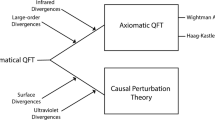Summary
The complete sets of restrictions among structure functions which stem from the semi-positive definiteness of the electromagnetic and weak hadronic tensors are derived. Applications are made to inelastic scattering of electrons or muons from polarized nucleons, inelastic scattering of polarized electrons or muons from polarized nucleons and inelastic scattering of neutrinos from nucleons with subsequent analysis of the polarization of the outgoing muon.
Riassunto
Si deduce il gruppo completo delle restrizioni fra le funzioni di struttura che nascono dalla definitezza semipositiva del tensore elettromagnetico e adronico debole. Lo si applica allo scattering anelastico di elettroni o muoni su nucleoni polarizzati, allo scattering anelastico di elettroni o muoni polarizzati su un nucleo polarizzato ed allo scattering anelastico di neutrini su nucleoni, con successiva analisi della polarizzazione del muone uscente.
Реэюме
Выводится полная система ограничений среди структурных функций, которые вытекают иэ полу-положительной определенности злектромагнитных и слабых адронных тенэоров. Рассматриваются применения к неупругому рассеянию злектронов или мюонов на поляриэованных нуклонах; к неупругому рассеянию поляриэованных злектронов или мюонов на поляриэованных нуклонах; и к неупругому рассеянию нейтрино на нуклонах с последуюшим аналиэом поляриэации вылетаюшего мюона.
Similar content being viewed by others
References
J. R. Chen, J. Sanderson, J. A. Appel, G. Gladding, M. Goitein, K. Hanson, D. C. Imrie, T. Kirk, R. Madaras, R. V. Pound, L. Price, R. Wilson andC. Zajde:Phys. Rev. Lett.,21, 1279 (1968).
S. Rock, M. Borghini, O. Chamberlain, R. Z. Fuzesy, C. C. Morehouse, T. Powell, G. Shapiro, H. Weisberg, R. L. A. Cottrell, J. Litt, L. W. Mo andR. E. Taylor:Phys. Rev. Lett.,24, 748 (1970).
For an excellent review, where earlier references can be found, seeC. H. Llewellyn Smith: CERN report TH 1188 (1970).
Our metric and Dirac matrices are those ofJ. D. Bjorken andS. D. Drell textbooks.
This is very similar to the method used byJ. D. Bjorken in his paperApplications of the chiral U 6 ⊗ U6 algebra of current densities;J. D. Bjorken:Phys. Rev.,148, 1467 (1966).
To our knowledge the spin-dependent structure functionsG 1 andG 2 were first discussed byIddings in connection with the problem of the nuclear-structure effects in the hyperfine splitting of the ground state of atomic hydrogen:C. K. Iddings:Phys. Rev.,138, B 466 (1965). This is the counterpart to the problem of the neutronproton electromagnetic mass difference whereW 1 andW 2 are involved:W. N. Cottingham:Ann. of Phys.,25, 424 (1963).
For a discussion of the positivity domain of spin-density matrices seeP. Minnaert:Phys. Rev. Lett.,16, 672 (1966);Phys. Rev.,151, 1306 (1966);M. G. Doncel: Thesis, Universidad de Barcelona (1967);L. Michel:Matrices densité de polarisation, IHES preprint (1967). For a complete study of positivity restrictions in two-particle reactions seeM. G. Doncel, L. Michel andP. Minnaert:Polarization density matrix, first and second issue of a series of preprints reproduced by Laboratoire de Physique Théorique, Université de Bordeaux, Talence. See also theLectures at the Ecole d’Eté de Gif-sur-Yvette, September 1970 (to be published).
These conditions have been previously discussed by a number of authors:N. Christ andT. D. Lee:Phys. Rev.,143, 1310 (1966);N. Dombey:Rev. Mod. Phys.,41, 236 (1969);J. D. Bjorken:Phys. Rev. D,1, 1376 (1970).
SeeN. Christ andT. D. Lee:Phys. Rev.,143, 1310 (1966), Appendix 6.
These restrictions are similar to those obtained by the application of the Eberhard-Good theorem to particle reactions:P. Eberhard andM. L. Good:Phys. Rev.,120, 1442 (1960). See also ref. (8).
The inequalities (3.3a), (3.3b) and (3.3c) are well known. See,e.g.,D. J. Gross andC. H. Llewellyn Smith:Nucl. Phys.,14 B, 337 (1969);J. D. Bjorken andE. A. Paschos:Phys. Rev. D,1, 3151 (1970). See alsoT. D. Lee andC. N. Yang:Phys. Rev.,126, 2239 (1962).
This has been discussed very much in detail byN. Christ andT. D. Lee:Phys. Rev.,143, 1310 (1966); and byC. A. Piketty:Nuovo Cimento,64 A, 39 (1966). We include a few comments here as an illustration of the applications of positivity.
For a discussion of the electromagnetic final-state interactions seeR. N. Cahn andY. S. Tsai:Phys. Rev.,20, 870 (1970).
J. D. Bjorken:Phys. Rev.,148, 1467 (1966);Phys. Rev. D,1, 1376 (1970).
In the elastic case, these effects can be rigorously bounded to order α. SeeA. de Rújula andE. de Rafael:Phys. Lett.,32 B, 495 (1970).
For a description of the deep inelastic electron scattering experiments see,e.g,R. E. Taylor:Inelastic electron-proton scattering in the deep continuum region, inProceedings of the IV International Symposium on Electron and Photon Interactions at High Energies (Daresbury, 1969).
Author information
Authors and Affiliations
Additional information
Work partially supported by the Spanish « Grupo Interuniversitario de Física Teórica ».
Rights and permissions
About this article
Cite this article
Doncel, M.G., de Rafael, E. Inelastic lepton scattering from nucleons and positivity restrictions. Nuov Cim A 4, 363–382 (1971). https://doi.org/10.1007/BF02728470
Received:
Published:
Issue Date:
DOI: https://doi.org/10.1007/BF02728470




